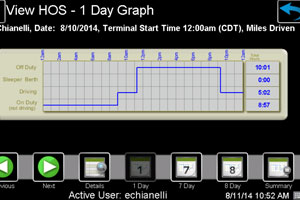Senior Reporter
FMCSA Announces Final ELD Rule

The Federal Motor Carrier Safety Administration on Dec. 10 announced its long-awaited final rule requiring that interstate drivers use electronic recording devices intended to enforce hours-of-service regulations, and reduce driver fatigue and paperwork for motor carriers and drivers.
The rule, which will not be effective for two years after publication in the Federal Register, details new technical specifications for ELDs that address statutory requirements, mandates the use of ELDs for all drivers currently using records of duty status, clarifies supporting document requirements and adopts both procedural and technical provisions aimed at ensuring that ELDs are not used to harass drivers. Update, Dec. 11: The rule is scheduled to be published Dec. 16, with a deadline date of compliance of Dec. 18, 2017.
“Since 1938, complex, on-duty/off-duty logs for truck and bus drivers were made with pencil and paper, virtually impossible to verify,” Transportation Secretary Anthony Foxx said. “This automated technology not only brings logging records into the modern age, it also allows roadside safety inspectors to unmask violations of federal law that put lives at risk.”
READ THE RULE: PDF at fmcsa.dot.gov
ATA SUMMARY: PDF at trucking.org
TELEMATICS IMPACT: Adoption rate predicted to accelerate
According to the 516-page document, the ELD Final Rule permits the use of smartphones and other wireless devices as ELDs, so long as they satisfy technical specifications, are certified and are listed on an agency website. Canada- and Mexico-domiciled drivers also will be required to use ELDs when operating on U.S. roadways.
Motor carriers who previously installed compliant Automatic On-Board Recording Devices may continue to use the devices for an additional two years beyond the compliance date.
FMCSA said the final ELD rule will result in an annual net benefit of more than $1 billion —largely by reducing the amount of required industry paperwork.
It also is intended to increase the efficiency of roadside law enforcement personnel in reviewing driver records.
On an annual average basis, the ELD final rule is estimated to save 26 lives and prevent 562 injuries resulting from crashes involving large commercial motor vehicles, FMCSA said.
The new rule includes several document requirements and technical changes from the supplemental proposed rule issued in March of last year.
The agency lowered to eight from 10 the number of maximum supporting documents to be retained and increased the timeframe to 13 days from eight days in which a driver must submit RODS and supporting documents to a motor carrier.
Are you in favor, or opposed to the new ELD regulations?
Also, Quick Response codes and TransferJet options for the required electronic data transfer included in the supplemental proposed rule have been removed. Electronic data transfer must be made by either wireless Web services and e-mail or Bluetooth and USB 2.0. Also, to facilitate roadside inspections and ensure access of data by authorized safety officials, an ELD must provide either a display or printout.
The final rule adds two optional exceptions from the required use of ELDs: Driveaway-towaway operations are not required to use an ELD, provided the vehicle driven is part of the shipment, and ELDs are not required on CMVs older than model year 2000.
In addition, to ensure that ELD providers have the opportunity for due process in the event of compliance issues with their product, procedures have been added to the final rule that FMCSA would employ if it identified problems with an ELD model before it would remove the model from the agency’s list of certified products, the rule said.
The final rule exempts drivers who use paper logs for not more than eight days during any 30-day period, drivers who conduct driveaway-towaway operations where a vehicle being used is the commodity being delivered and drivers of vehicles manufactured before model year 2000.
The agency defined supporting documents as bills of lading, itineraries, schedules or equivalent documents that indicate the origin and destination of each trip, dispatch records, trip records or equivalent documents,expense receipts, electronic mobile communication records, reflecting communications transmitted through a fleet management system and payroll records and settlement sheets or equivalent documents that indicates payment to a driver.




